Study of Township Construction Land Carrying Capacity and Spatial Pattern Matching in Loess Plateau Hilly and Gully Region: A Case of Xifeng in China
Abstract
1. Introduction
2. Materials and Methods
2.1. The Study Area
2.2. Data Sources
2.3. Research Framework
2.4. The Township Construction Land Suitability Evaluation
2.4.1. Indicator System Construction
2.4.2. Township Construction Land Suitability Evaluation
2.5. Township Construction Land Carrying Capacity Evaluation
2.6. Township Construction Land Development Potential Evaluation
2.7. Spatial Pattern Matching Evaluation
3. The Analysis of Results
3.1. Suitability Evaluation Analysis of Township Construction Land
3.2. Analysis of Township Construction Land Carrying Capacity
3.2.1. Analysis of Township Construction Land Carrying Capacity
3.2.2. Analysis of Township Construction Land Development Potential
3.3. Spatial Pattern Matching Mnalysis of Township Construction Land
4. The Discussion and Conclusions
4.1. Discussion
4.2. Conclusions
4.3. Suggestion
Author Contributions
Funding
Institutional Review Board Statement
Informed Consent Statement
Data Availability Statement
Conflicts of Interest
References
- Liu, Y. New progress of land resources studies and related developmental tendencies in China. Chin. J. Eco-Agric. 2013, 21, 127–133. [Google Scholar] [CrossRef]
- Wu, Q.; Cao, Y.; Fang, X.; Wang, J.; Li, G. A systematic coupling analysis framework and multi-stage interaction mechanism between urban land use efficiency and ecological carrying capacity. Sci. Total Environ. 2022, 853, 158444. [Google Scholar] [CrossRef] [PubMed]
- Han, Y.; Niu, J.; Wu, F. Land-use changes in the small watershed of the Loess Plateau, hilly-gully region, China. J. For. Res. 2015, 26, 91–99. [Google Scholar] [CrossRef]
- Running, S. A Measurable Planetary Boundary for the Biosphere. Science 2012, 337, 1458–1459. [Google Scholar] [CrossRef]
- Liu, B.; Zhang, B.; Feng, H.; Wu, S.; Yang, J.; Zou, Y.; Siddique, K.H.M. Ephemeral gully recognition and accuracy evaluation using deep learning in the hilly and gully region of the Loess Plateau in China. Int. Soil Water Conserv. Res. 2022, 10, 371–381. [Google Scholar] [CrossRef]
- Ou, M.; Lai, X.; Gong, J. Territorial Pattern Evolution and Its Comprehensive Carrying Capacity Evaluation in the Coastal Area of Beibu Gulf, China. Int. J. Environ. Res. Public Health 2022, 19, 469. [Google Scholar] [CrossRef]
- Josef, Z.; Jaroslav, K. The Concept of Carrying Capacity in Tourism. Amfiteatru Econ. 2014, 16, 641–654. Available online: https://doaj.org/article/6fa383a5002a456b809b15cb9c76adb3 (accessed on 19 November 2022).
- Di, Q.; Han, Z.; Liu, G.; Chang, H. Carrying capacity of marine region in Liaoning Province. Chin. Geogr. Sci. 2007, 17, 229–235. [Google Scholar] [CrossRef]
- Feng, Z.; Weike, Z.; Yanzhao, Y. China’s Land Carrying Capacity Based on Man-grain Relationships. Chin. J. Popul. Resour. Environ. 2013, 7, 51–58. [Google Scholar] [CrossRef]
- Gifford, R.M.; Millington, R.J. Energetics of agriculture and food production: With special emphasis on the Australian situation. CSIRO Bull. 1975, 288, 1–25. [Google Scholar] [CrossRef]
- Fearnside, P.M. Estimation of human carrying capacity in rainforest areas. Trends Ecol. Evol. 1990, 5, 192–196. [Google Scholar] [CrossRef] [PubMed]
- Kessler, J.J. Usefulness of the human carrying capacity concept in assessing ecological sustainability of land-use in semi-arid regions. Agric. Ecosyst. Environ. 1994, 48, 273–284. [Google Scholar] [CrossRef]
- Sun, T.; Feng, Z.; Yang, Y.; Lin, Y.; Wu, Y. Research on Land Resource Carrying Capacity: Progress and Prospects. J. Resour. Ecol. 2018, 9, 331–340. [Google Scholar] [CrossRef]
- Li, K.; Jin, X.; Ma, D.; Jiang, P. Evaluation of Resource and Environmental Carrying Capacity of China’s Rapid-Urbanization Areas—A Case Study of Xinbei District, Changzhou. Land 2019, 8, 69. [Google Scholar] [CrossRef]
- Swiader, M.; Szewrański, S.; Kazak, J. Environmental Carrying Capacity Assessment—The Policy Instrument and Tool for Sustainable Spatial Management. Front. Environ. Sci. 2020, 8, 579838. [Google Scholar] [CrossRef]
- Pahuluan, A.; Soeprobowati, T.; Hadiyanto, H. Environmental carrying capacity based on land balance for evaluation planning of spatial and regional in Solok regency, West Sumatra. J. Ecol. Eng. 2017, 18, 22–30. [Google Scholar] [CrossRef][Green Version]
- Rong, L.; Bi, K. A study on the comprehensive carrying capacity and spatial optimization under the new development concept—An empirical study of Shandong province. E3S Web Conf. 2020, 199, 00005. [Google Scholar] [CrossRef]
- Sun, M.; Wang, J.; He, K. Analysis on the urban land resources carrying capacity during urbanization—A case study of Chinese YRD. Appl. Geogr. 2020, 116, 102170. [Google Scholar] [CrossRef]
- Baby, S.; Nathawat, M.S.; Al-Sarawi, M.A. Major Impacts from Anthropogenic Activities on Landscape Carrying Capacity of Kuwaiti Coast. Pol. J. Environ. Stud. 2014, 23, 7–17. Available online: https://www.semanticscholar.org/paper/Major-Impacts-from-Anthropogenic-Activities-on-of-Baby-Nathawat/6705ecd21e6702cf8f1dc74e763c470a8e5d248d (accessed on 20 November 2022).
- Mamat, H.; Husen, E. Socio-economic aspect and carrying capacity of agricultural land resources to support the development of strategic agricultural commodities. IOP Conf. Ser. Earth Environ. Sci. 2021, 648, 012019. [Google Scholar] [CrossRef]
- Sugiyarto, S.; Hariono, B.; Wijaya, R.; Destarianto, P.; Novawan, A. The impact of land use changes on carrying capacity of sampean watershed in Bondowoso Regency. IOP Conf. Ser. Earth Environ. Sci. 2018, 207, 012005. [Google Scholar] [CrossRef]
- Oktaviani, S.; Yonvitner, Y.; Imran, Z.; Program, S.; Pengelolaan, S.; Pesisir, D.; Lautan, S.; Pascasarjana, I.; Manajemen, D.; Perairan, S.; et al. Daya Dukung Optimum Berbasis Pola Tata Guna Lahan Pesisir di Muara Gembong, Kabupaten Bekasi. J. Teknol. 2019, 11, 2087–9423. [Google Scholar] [CrossRef]
- Pahuluan, A.; Soeprobowati, T.; Hadiyanto, H. Analysis of Environmental Carrying Capacity Based on Land Balance in Solok Regency, West Sumatra. Adv. Sci. Lett. 2017, 23, 2407–2409. [Google Scholar] [CrossRef]
- Widodo, W.; Widodo, A.; Melrhoza, N. Evaluation of Land Carrying Capacity in Tsunami Affected Areas of Aceh Besar Regency. In Proceedings of the 4th International Conference on Food, Agriculture and Natural Resources (FANRes 2018), Bantul, Indonesia, 12–14 September 2018. [Google Scholar] [CrossRef][Green Version]
- Tjahja, A.; Prayitno, G.; Widhi, N. Analysis of land carrying capacity for the development of leading commodities in Kulon Progo Regency, Indonesia. Int. J. GEOMATE 2019, 16, 171–176. [Google Scholar] [CrossRef]
- Hakim, A.M.Y.; Baja, S.; Rampisela, A.; Arif, S. Quantifying future environmental carrying capacity based on land use/land cover data and ecosystem services valuation: A case study in Makassar City, Indonesia. Int. J. Environ. Stud. 2021, 79, 686–697. [Google Scholar] [CrossRef]
- Sobhani, P.; Esmaeilzadeh, H.; Sadeghi, S.M.M.; Marcu, M.V. Estimation of Ecotourism Carrying Capacity for Sustainable Development of Protected Areas in Iran. Int. J. Environ. Res. Public Health 2022, 19, 1059. [Google Scholar] [CrossRef] [PubMed]
- Wicaksono, A.; Abdul Khafid, M.; Fakhruddin, F. Evaluation of environment carrying capacity as a coastal tourism using GIS in Sepanjang Beach, Indonesia. IOP Conf. Ser. Mater. Sci. Eng. 2020, 830, 032080. [Google Scholar] [CrossRef]
- Kafafa, U.; Nadia, H.; Fadilah, G.; Abadi, A.; Putri, R. Carrying capacity trend and projection analysis for Sumatra Selatan agricultural land in 2030. IOP Conf. Ser. Earth Environ. Sci. 2020, 451, 012046. [Google Scholar] [CrossRef]
- Arimjaya, I.W.G.; Supriatna, S. Potential Development of Spatial Dynamics Modeling Research in Indonesia for Environmental Carrying Capacity Analysis. In Seventh Geoinformation Science Symposium 2021; SPIE: Bellingham, WA, USA, 2021; Volume 12082, pp. 406–415. [Google Scholar] [CrossRef]
- Sriyana, I. Evaluation of watershed carrying capacity for watershed management (a case study on Bodri watershed, Central Java, Indonesia). MATEC Web Conf. 2018, 195, 05003. [Google Scholar] [CrossRef]
- Noywuli, N.; Sapei, A.; Pandjaitan, N.; Eriyatno, E. Assessment of Watershed Carrying Capacity for the Aesesa Flores Watershed Management, East Nusa Tenggara Province of Indonesia. Environ. Nat. Resour. J. 2019, 17, 29–39. [Google Scholar] [CrossRef]
- Kurniasari, K.; Santi, D.; Rahmawati, L.; Taufiq, D.; Laksono, A.; Maulidina, W.; Putri, R.; Harini, R.; Sumantyo, J. Land Resource Analysis in Jakarta Special Province, Indonesia. In E3S Web of Conferences; EDP Sciences: Les Ulis, France, 2020; Volume 200. [Google Scholar] [CrossRef]
- Djaja, I.; Purwanto, P.; Sunoko, H.R. Analysis of land carrying capacity of Tanah Miring district of Merauke regency. Adv. Sci. Lett. 2017, 23, 2561–2563. [Google Scholar] [CrossRef]
- Ma, B. Literature Review on Land Carrying Capacity of the Coordinated Development of Population, Resources, Environment and Economy. In 2nd International Conference on Materials Science, Resource and Environmental Engineering; AIP Publishing LLC: Melville, NY, USA, 2017; Volume 1890, p. 040106. [Google Scholar] [CrossRef]
- Liu, Y.; Quan, Q.; Wang, F.; Wang, C.; Meng, Z. Evaluation and Space-Temporal Evolution Analysis of Comprehensive Carrying Capacity in Chengdu Urban Agglomeration. In International Conference on Management Science and Engineering Management; Springer: Cham, Switzerland, 2019; pp. 1205–1221. [Google Scholar] [CrossRef]
- Nie, X.; Li, K. Evaluation on Spatial of National Land Development Pattern of Lanzhou-Xining Urban Agglomeration Based on Resource and Environment Carrying Capacity. IOP Conf. Ser. Earth Environ. Sci. 2020, 428, 012053. [Google Scholar] [CrossRef]
- Huang, H.; Wang, R.; Wang, J.; Chai, J.; Xiao, Y. Temporal and spatial evolution and obstacle diagnosis of resource and environment carrying capacity in the Loess Plateau. PLoS ONE 2021, 16, e0256334. [Google Scholar] [CrossRef] [PubMed]
- Yang, N.; Li, J.; Lu, B.; Luo, M.; Li, L. Exploring the Spatial Pattern and Influencing Factors of Land Carrying Capacity in Wuhan. Sustainability 2020, 11, 2786. [Google Scholar] [CrossRef]
- Zhang, Z.; Ou, G.; Elshkaki, A.; Liu, R. Evaluation of Regional Carrying Capacity under Economic-Social-Resource-Environment Complex System: A Case Study of the Yangtze River Economic Belt. Sustainability 2022, 14, 7117. [Google Scholar] [CrossRef]
- Tsou, J.Y.; Gao, Y.; Zhang, Y.; Genyun, S.; Ren, J.; Li, Y. Evaluating Urban Land Carrying Capacity Based on the Ecological Sensitivity Analysis: A Case Study in Hangzhou, China. Remote Sens. 2017, 9, 529. [Google Scholar] [CrossRef]
- Lu, X.; Zhang, Y.; Chaoran, L.; Wu, F. Analysis and comprehensive evaluation of sustainable land use in China: Based on sustainable development goals framework. J. Clean. Prod. 2021, 310, 127205. [Google Scholar] [CrossRef]
- Tang, Q.; Wang, J.; Jing, Z.; Yan, Y.; Niu, H. Response of ecological vulnerability to land use change in a resource-based city, China. Resour. Policy 2021, 74, 102324. [Google Scholar] [CrossRef]
- Chen, J.; Zhang, H.; Zhou, P. Evaluation of Land Carrying Capacity of Island Cities: Based on the Modified Ecological Footprint Model. In Proceedings of the 20th International Symposium on Advancement of Construction Management and Real Estate; Springer: Singapore, 2017; pp. 181–190. [Google Scholar] [CrossRef]
- Benhong, P.; Li, Y.; Elahi, E.; Wei, G. Dynamic evolution of ecological carrying capacity based on the ecological footprint theory: A case study of Jiangsu province. Ecol. Indic. 2019, 99, 19–26. [Google Scholar] [CrossRef]
- Wang, Q. A Fuzzy Comprehensive Evaluation Method of Area Resource Carrying Capacity. Int. J. Circuits Syst. Signal Process. 2021, 14, 1137–1153. [Google Scholar] [CrossRef]
- Liu, Y.; Wang, F. A Dynamic Evaluation of the Comprehensive Carrying Capacity of Chengdu Urban. In Proceedings of the Tenth International Conference on Management Science and Engineering Management; Springer: Singapore, 2017; pp. 1677–1692. [Google Scholar] [CrossRef]
- Wei, C.; Dai, X.; Guo, Y.; Tong, X.; Wu, J. An Improved Approach of Integrated Carrying Capacity Prediction Based on TOPSIS-SPA. Sustainability 2022, 14, 4051. [Google Scholar] [CrossRef]
- Wang, Z. Land Spatial Development Based on Carrying Capacity, Land Development Potential, and Efficiency of Urban Agglomerations in China. Sustainability 2018, 10, 4701. [Google Scholar] [CrossRef]
- Zhao, L.; Shao, Q.; Li, J. Evaluation of urban comprehensive carrying capacity: Case study of the Beijing–Tianjin–Hebei urban agglomeration, China. Environ. Sci. Pollut. Res. 2020, 27, 19774–19782. [Google Scholar] [CrossRef] [PubMed]
- Cao, X.; Shi, Y.; Zhou, L. Research on Urban Carrying Capacity Based on Multisource Data Fusion—A Case Study of Shanghai. Remote Sens. 2021, 13, 2695. [Google Scholar] [CrossRef]
- Yuan, L. Spatiotemporal evolution characteristics of comprehensive land carrying capacity of urban–rural interlaced zone: A case study of Chenggong, China. Arab. J. Geosci. 2022, 15, 591. [Google Scholar] [CrossRef]
- Deng, L.; Shangguan, Z. High Quality Developmental Approach for Soil and Water Conservation and Ecological Protection on the Loess Plateau. Front. Agric. Sci. Eng. 2021, 8, 501–511. [Google Scholar] [CrossRef]
- Luo, W.; Ren, Y.; Shen, L.; Zhu, M.; Jiang, Y.; Meng, C.; Zhang, P. An evolution perspective on the urban land carrying capacity in the urbanization era of China. Sci. Total Environ. 2020, 744, 140827. [Google Scholar] [CrossRef]
- Dong, J.; Zhang, Z.; Liu, B.; Zhang, X.; Zhang, W.; Chen, L. Spatiotemporal variations and driving factors of habitat quality in the loess hilly area of the Yellow River Basin: A case study of Lanzhou City, China. J. Arid Land 2022, 14, 637–652. [Google Scholar] [CrossRef]
- Wang, G.; Yang, D.; Xia, F.; Zhong, R.; Xiong, C. Three Types of Spatial Function Zoning in Key Ecological Function Areas Based on Ecological and Economic Coordinated Development: A Case Study of Tacheng Basin, China. Chin. Geogr. Sci. 2019, 29, 689–699. [Google Scholar] [CrossRef]
- Dong, X.; He, M.; Li, H.; Meng, W. Construction of Ecological Protection Red Line and Integration Ecological Network in Beijing-Tianjin-Hebei Region. IOP Conf. Ser. Mater. Sci. Eng. 2018, 392, 042036. [Google Scholar] [CrossRef]
- Fu, Y.; Shi, X.; He, J.; Yuan, Y.; Qu, L. Identification and optimization strategy of county ecological security pattern: A case study in the Loess Plateau, China. Ecol. Indic. 2020, 112, 106030. [Google Scholar] [CrossRef]
- Sun, L.; Zhou, J.; Cai, Q.; Liu, S.; Xiao, J. Comparing surface erosion processes in four soils from the Loess Plateau under extreme rainfall events. Int. Soil Water Conserv. Res. 2021, 9, 520–531. [Google Scholar] [CrossRef]
- Shi, H.; Shao, M. Soil and water loss from the Loess Plateau in China. J. Arid Environ. 2000, 45, 9–20. [Google Scholar] [CrossRef]
- Fu, B.-J. Soil erosion and its control in the Loess Plateau of China. Soil Use Manag. 2007, 5, 76–82. [Google Scholar] [CrossRef]
- Bao, C.; Zou, J. Analysis of spatiotemporal changes of the human-water relationship using water resources constraint intensity index in Northwest China. Ecol. Indic. 2018, 84, 119–129. [Google Scholar] [CrossRef]
- Su, H.; Zhao, X.; Wang, W.; Jiang, L.; Xue, B. What factors affect the water saving behaviors of farmers in the Loess Hilly Region of China? J. Environ. Manag. 2021, 292, 112683. [Google Scholar] [CrossRef]
- Çoruhlu, Y.E.; Çelik, M.Ö. Protected area geographical management model from design to implementation for specially protected environment area. Land Use Policy 2022, 122, 106357. [Google Scholar] [CrossRef]
- Gumisiriza, T.L. Effects of Geomorphic Processes and Land Use Activities on Slope Stability in Mount Elgon Region, Eastern Uganda. 2014. Available online: https://www.semanticscholar.org/paper/Effects-of-geomorphic-processes-and-land-use-on-in-Gumisiriza/8264df48be2eea3176878521c13d2253f3a65773 (accessed on 22 November 2022).
- Xu, Y.; Zhao, S.; Fan, J. Urban planning construction land standard and its revision based on climate and topography in China. J. Geogr. Sci. 2021, 31, 603–620. [Google Scholar] [CrossRef]
- Yu, Z.; Lixia, Y.; Bingbing, H.; Yajie, W. Impact of the Rainfall Intensity and Seepage on Slope Stability in Loess Plateau. 2021. Available online: https://www.semanticscholar.org/paper/Impact-of-the-Rainfall-Intensity-and-Seepage-on-in-Yu-Lixia/54f945d0a738623d1daf2e48bb0e2801d1db562e (accessed on 22 November 2022).
- Wang, J.; Zhong, L.; Ying, L. The influence of rainfall and land use patterns on soil erosion in multi-scale watersheds: A case study in the hilly and gully area on the Loess Plateau, China. J. Geogr. Sci. 2018, 28, 1415–1426. [Google Scholar] [CrossRef]
- Yuan, X.; Han, J.; Shao, Y.; Li, Y.; Wang, Y. Geodetection analysis of the driving forces and mechanisms of erosion in the hilly-gully region of northern Shaanxi Province. J. Geogr. Sci. 2019, 29, 779–790. [Google Scholar] [CrossRef]
- Zhang, X.; Fang, C.; Wang, Z.; Ma, H. Urban Construction Land Suitability Evaluation Based on Improved Multi-criteria Evaluation Based on GIS (MCE-GIS): Case of New Hefei City, China. Chin. Geogr. Sci. 2013, 23, 740–753. [Google Scholar] [CrossRef]
- Emeksiz, C.; Demirci, B. The determination of offshore wind energy potential of Turkey by using novelty hybrid site selection method. Sustain. Energy Technol. Assess. 2019, 36, 100562. [Google Scholar] [CrossRef]
- Zenk, H.; Baser, V.; Guner, F. Evaluation of offshore wind power plant sustainability: A case study of Sinop/Gerze, Turkey. Int. J. Glob. Warm. 2021, 23, 370–384. [Google Scholar] [CrossRef]
- Ma, Y.; Xue, F.; Yang, Z. Coupling study on territory space suitability evaluation and construction land expansion simulation: A case study of Jiangxi province, China. Environ. Dev. Sustain. 2022, 127, 1–20. [Google Scholar] [CrossRef]
- Xu, K.; Kong, C.; Li, J.; Zhang, L.; Wu, C. Suitability evaluation of urban construction land based on geo-environmental factors of Hangzhou, China. Comput. Geosci. 2011, 37, 992–1002. [Google Scholar] [CrossRef]
- An, H.; Zhao, S. Evaluation of Land Ecological Security in Liaoning Province based on Grid. IOP Conf. Ser. Earth Environ. Sci. 2018, 178, 012047. [Google Scholar] [CrossRef]
- Yi, D.; Zhao, X.-M.; Guo, X.; Jiang, Y.-F.; Wang, C.-L.; Lai, X.-H.; Huang, X.-Y.; Chen, L. Evaluation of carrying capacity and spatial pattern matching on urban-rural construction land in the Poyang Lake urban agglomeration, China. Ying Yong Sheng Tai Xue Bao = J. Appl. Ecol. 2019, 30, 627–636. [Google Scholar] [CrossRef]
- Han, H.; Li, H. Coupling Coordination Evaluation between Population and Land Urbanization in Ha-Chang Urban Agglomeration. Sustainability 2020, 12, 357. [Google Scholar] [CrossRef]
- Yu, J.; Zhou, K.; Yang, S. Land use efficiency and influencing factors of urban agglomerations in China. Land Use Policy 2019, 88, 104143. [Google Scholar] [CrossRef]
- Wang, L.; Huang, J.; Du, Y.; Hu, Y.; Han, P.; Wang, J. Priority Areas Mapping for Controlling Soil Erosion in Danjiangkou Reservoir Area. Adv. Mater. Res. 2012, 610–613, 2995–2999. [Google Scholar]
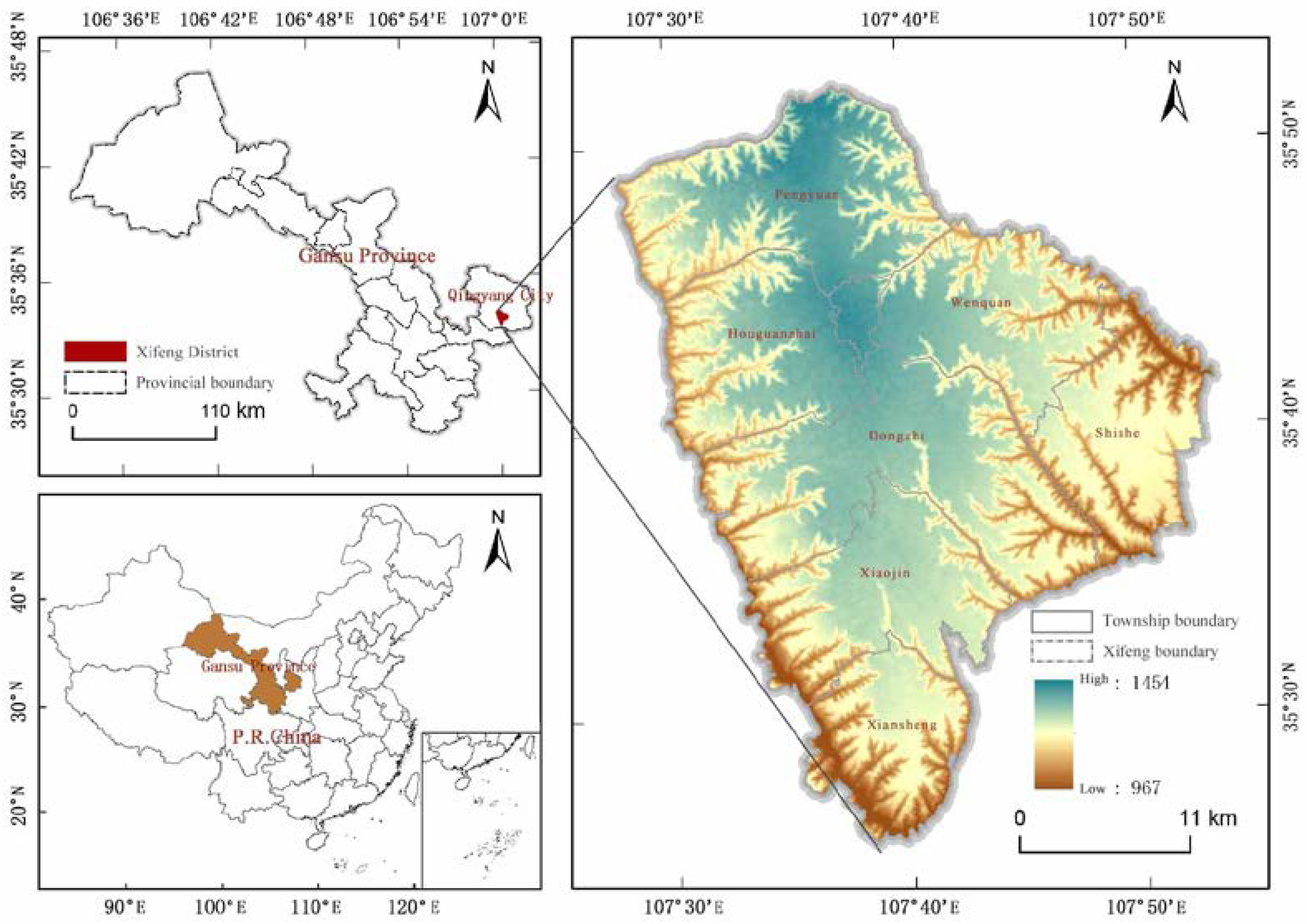
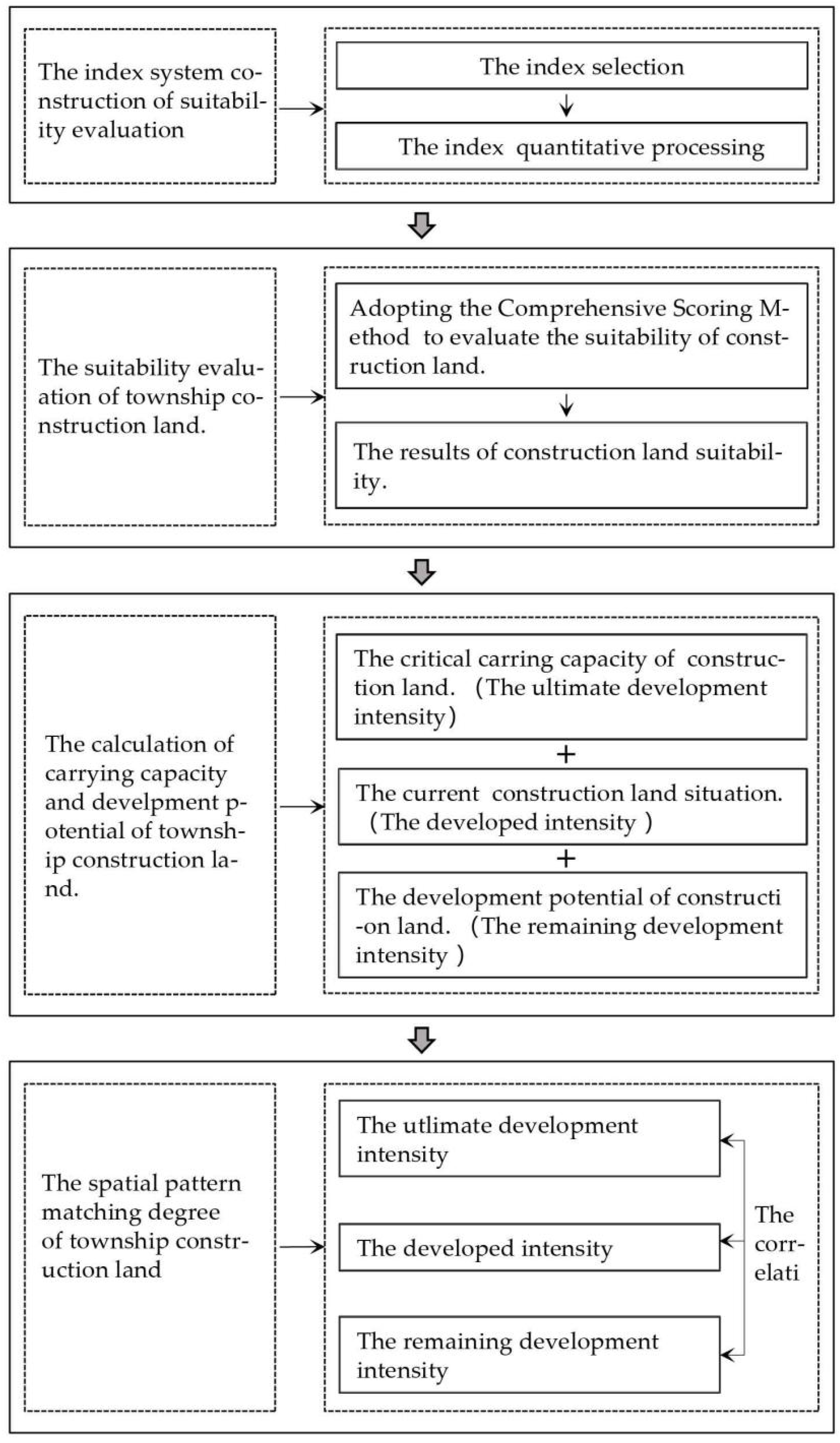
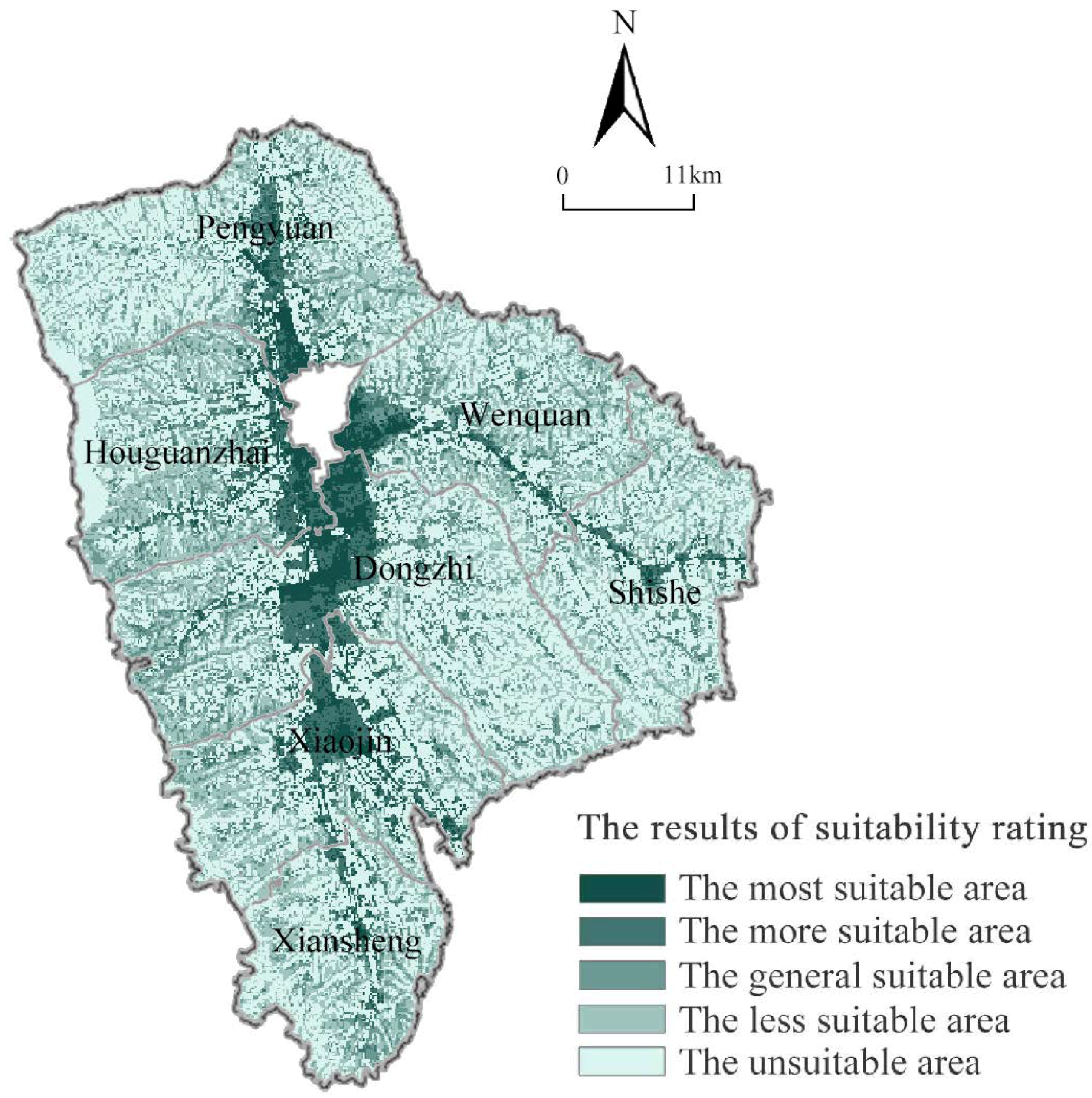
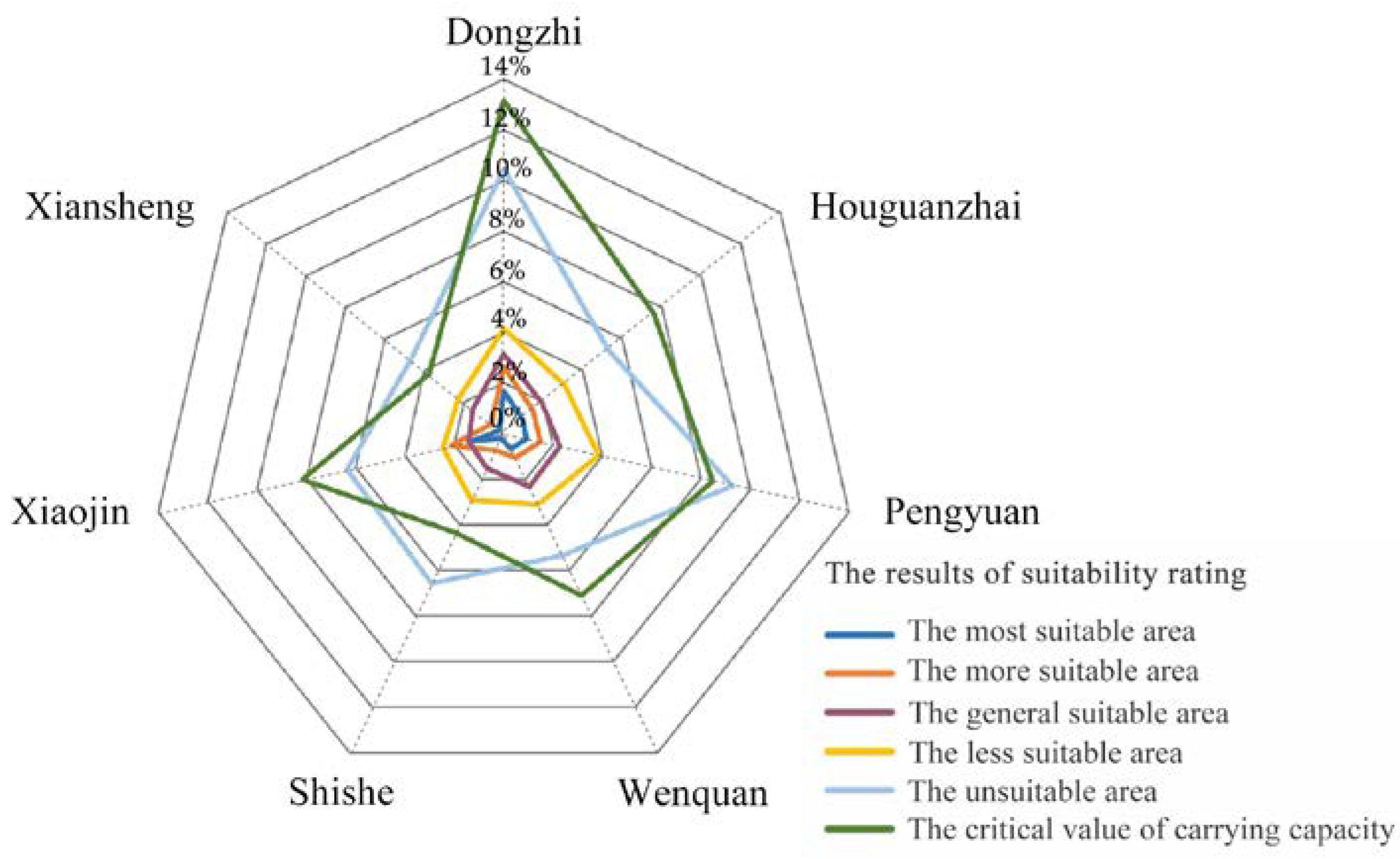
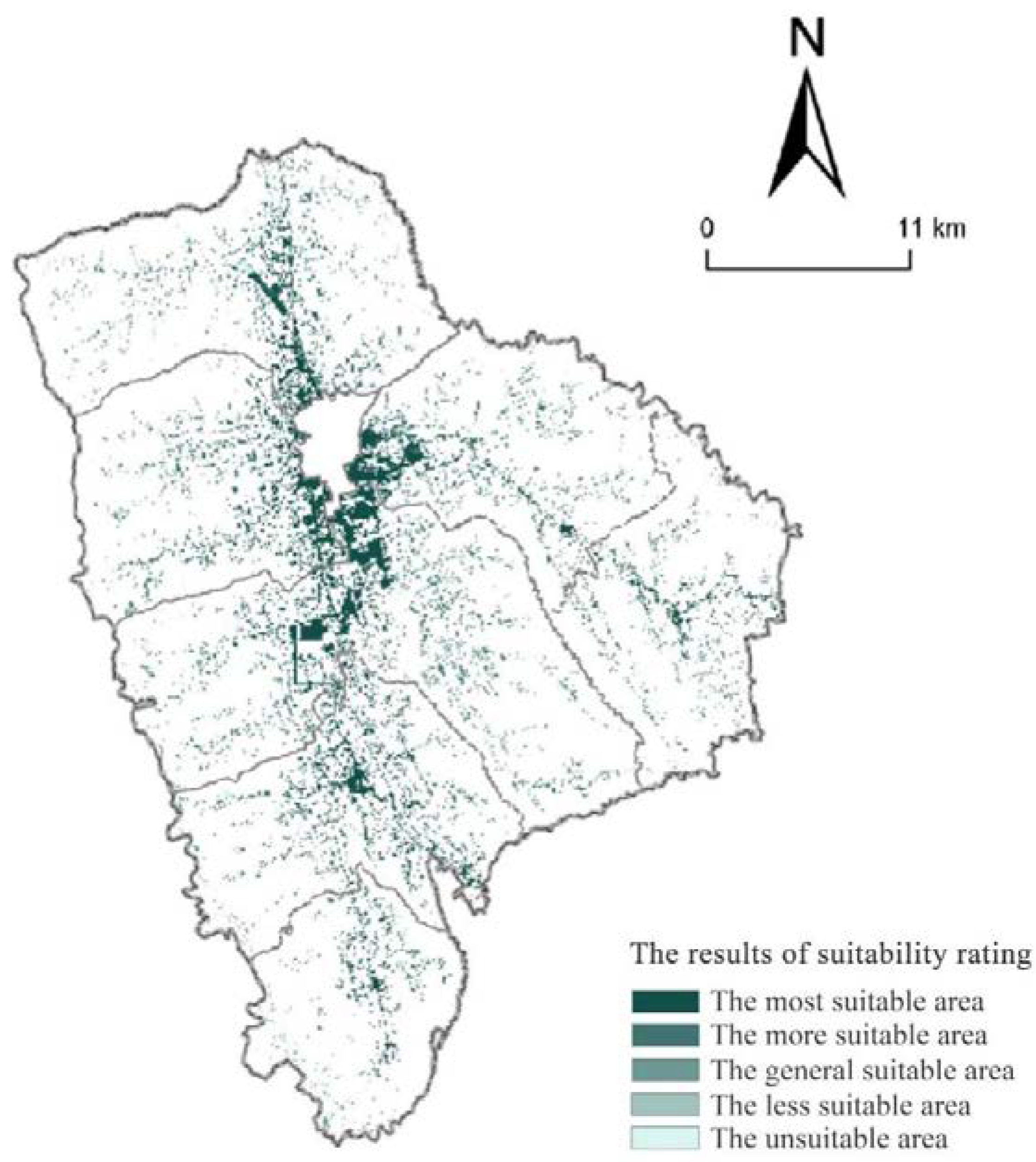
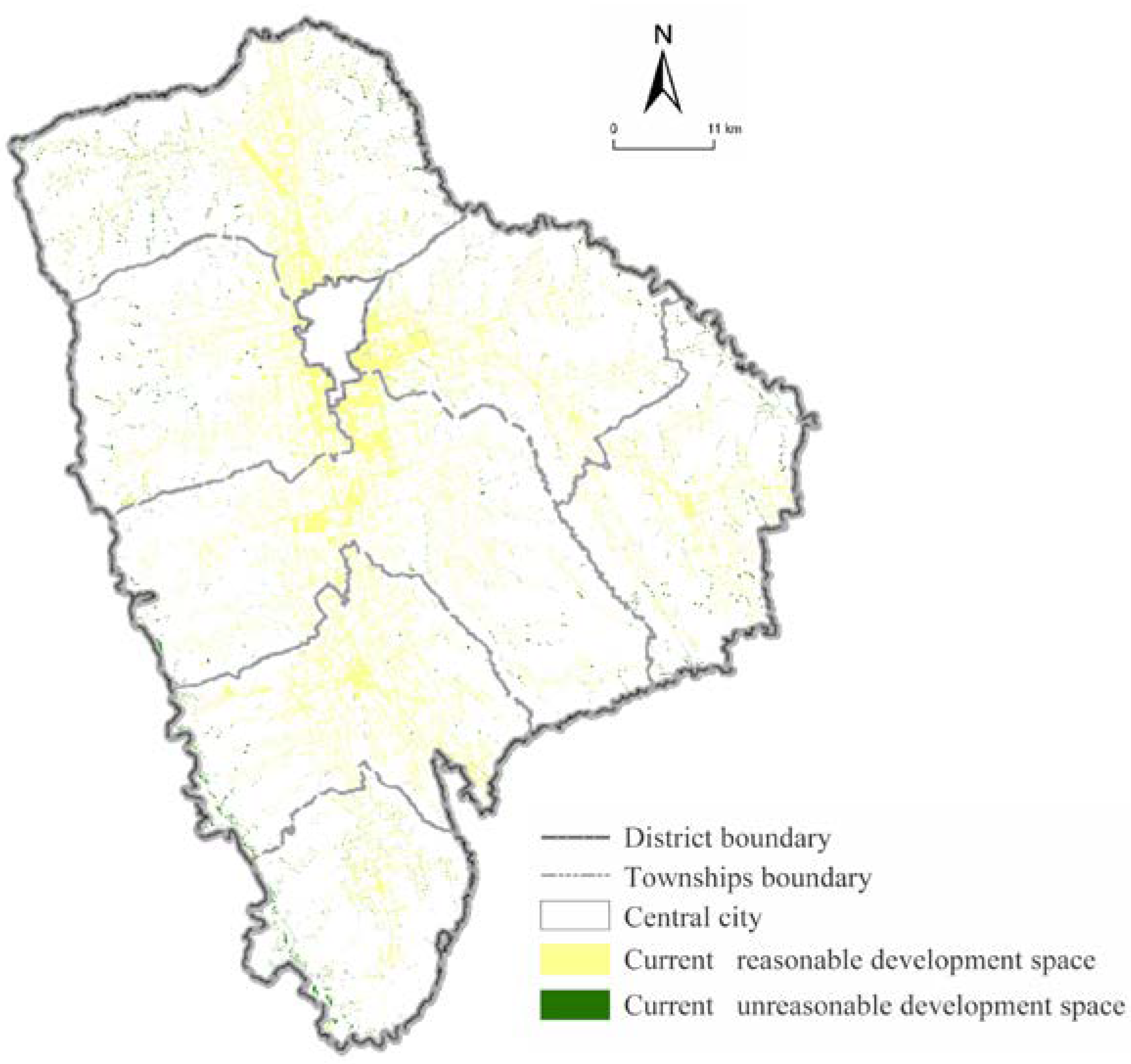
| Indicator Type | Middle Layer | Index Factor | Factor Grading | Assignment | Weights |
|---|---|---|---|---|---|
| The strongly binding indicators | The ecological protection | The ecological protection red line | The ecological protection red line | 0 | |
| Other | 1 | ||||
| The permanent basic farmland | The permanent basic farmland | 0 | |||
| Other | 1 | ||||
| Water areas | Water areas | 0 | |||
| Other | 1 | ||||
| The less strong binding indicators | The natural environment | Slope | >25° | 1 | 0.1193 |
| 15°–25° | 3 | ||||
| 8°–15° | 5 | ||||
| 3°–8° | 7 | ||||
| 0–3° | 10 | ||||
| Elevation | >1400 m | 1 | 0.0327 | ||
| 1250 m–1400 m | 2 | ||||
| 1100 m–1250 m | 5 | ||||
| 1000 m–1100 m | 7 | ||||
| 0–1000 m | 10 | ||||
| Geological disasters | The high zone of geological disasters | 2 | 0.3365 | ||
| The middle-zone of geological disasters | 6 | ||||
| The low zone of geological disasters | 8 | ||||
| No geological hazard zone | 10 | ||||
| The current land use | Gardens, woodlands, wetlands | 3 | 0.2224 | ||
| Other land | 5 | ||||
| Grassland, unused | 7 | ||||
| Construction land | 10 | ||||
| The social economy | The distance from national highway | >5000 m | 1 | 0.0845 | |
| 3500 m–5000 m | 3 | ||||
| 2000 m–3500 m | 5 | ||||
| 1000 m–2000 m | 7 | ||||
| 0–1000 m | 10 | ||||
| The distance from provincial roads | >3000 m | 1 | 0.0742 | ||
| 2000 m–3000 m | 3 | ||||
| 1000 m–2000 m | 5 | ||||
| 500 m–1000 m | 7 | ||||
| 0–500 m | 10 | ||||
| The distance from county roads | >1500 m | 1 | 0.1304 | ||
| 1000 m–1500 m | 3 | ||||
| 500 m–1000 m | 5 | ||||
| 300 m–500 m | 7 | ||||
| 0–300 m | 10 |
| The Rating of Suitability Evaluation | The Divided Standard | Areas (km2) | Proportion (%) |
|---|---|---|---|
| The most suitable area | 7.63–9.77 | 58.15 | 5.88 |
| The more suitable area | 6.14–7.63 | 100.47 | 10.15 |
| The general suitable area | 4.83–6.14 | 140.33 | 14.18 |
| The less suitable area | 3.58–4.83 | 215.87 | 21.82 |
| The unsuitable area | 2.18–3.58 | 474.69 | 47.97 |
| Administrative Area | The Ultimate Development Intensity (%) | The Developed Intensity (%) | The Remaining Development Intensity (%) |
|---|---|---|---|
| Dongzhi | 10.32 | 2.84 | 7.48 |
| Houguanzhai | 5.98 | 1.63 | 4.35 |
| Pengyuan | 6.58 | 1.89 | 4.69 |
| Wenquan | 5.58 | 1.52 | 4.06 |
| Shishe | 3.42 | 0.94 | 2.48 |
| Xiaojin | 6.47 | 1.69 | 4.78 |
| Xiansheng | 3.08 | 0.70 | 2.38 |
Publisher’s Note: MDPI stays neutral with regard to jurisdictional claims in published maps and institutional affiliations. |
© 2022 by the authors. Licensee MDPI, Basel, Switzerland. This article is an open access article distributed under the terms and conditions of the Creative Commons Attribution (CC BY) license (https://creativecommons.org/licenses/by/4.0/).
Share and Cite
Zhao, Y.; Li, T.; Li, J.; Song, M. Study of Township Construction Land Carrying Capacity and Spatial Pattern Matching in Loess Plateau Hilly and Gully Region: A Case of Xifeng in China. Int. J. Environ. Res. Public Health 2022, 19, 16316. https://doi.org/10.3390/ijerph192316316
Zhao Y, Li T, Li J, Song M. Study of Township Construction Land Carrying Capacity and Spatial Pattern Matching in Loess Plateau Hilly and Gully Region: A Case of Xifeng in China. International Journal of Environmental Research and Public Health. 2022; 19(23):16316. https://doi.org/10.3390/ijerph192316316
Chicago/Turabian StyleZhao, Yirui, Tongsheng Li, Julin Li, and Mengwei Song. 2022. "Study of Township Construction Land Carrying Capacity and Spatial Pattern Matching in Loess Plateau Hilly and Gully Region: A Case of Xifeng in China" International Journal of Environmental Research and Public Health 19, no. 23: 16316. https://doi.org/10.3390/ijerph192316316
APA StyleZhao, Y., Li, T., Li, J., & Song, M. (2022). Study of Township Construction Land Carrying Capacity and Spatial Pattern Matching in Loess Plateau Hilly and Gully Region: A Case of Xifeng in China. International Journal of Environmental Research and Public Health, 19(23), 16316. https://doi.org/10.3390/ijerph192316316





